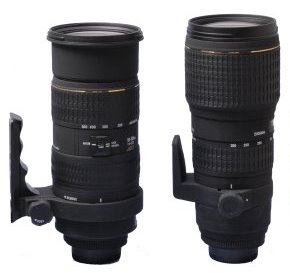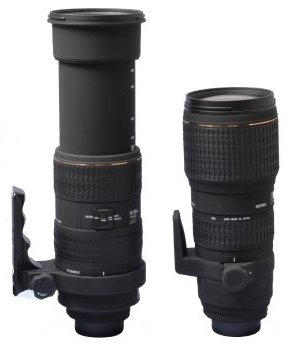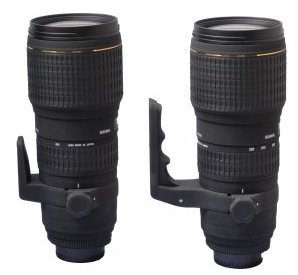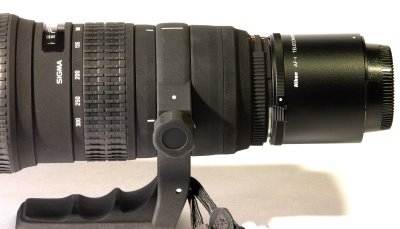Sigma 100-300 and 50-500 zoomsSomeone once gave an eminently practical definition of "professional" photographic equipment: "Pro" stuff is either too heavy for normal people to carry, or too expensive for normal people to buy, or both. I tend to agree with this definition, with a few exceptions. One of these is that even a professional photographer sometimes needs to carry lenses without hiring a troupe of sherpas to lug them around. The two zooms discussed on this page fit into this category. They give excellent results, are often used by semi-professional and professional photographers, weight between roughly 1.5 and 2 kg, and either one fits into a medium-sized camera bag or backpack together with a few smaller lenses. They are bigger and heavier than typical all-round zooms in the 70-200 mm range, but not so much so that you cannot carry one of them in your bag if you expect to need a higher focal length. These lenses are the Sigma Apo 100-300 f/4 EX and the Sigma Apo 50-500 f/4-6.3 EX. Both are available in the DG (with coating said to be optimized for digital cameras) and non-DG series (the latter can be found mostly in the second-hand market). I have not found any difference in performance between DG and non-DG Sigma lenses, and have never seen any convincing evidence to the contrary. Given a choice, I would pay less and get a non-DG lens. I use these two zooms mostly for wildlife and bird photography. In the illustration below, the 50-500 mm is at the left, and the 100-300 at the right. These lenses are roughly the same in general size. Both also sport a rotating tripod collar, a plastic petal lens hood, and HSM autofocus (which is equivalent to Nikon's AF-S autofocus). Both lenses also share the Sigma black matte finish found on their EX lens series. The filter mounts are 86 and 82 mm in diameter, respectively, which means a Skylight or polarizer filter is rather expensive, but not impossible to find. Neither lens has an internal filter carrier. 
Beyond these similarities, these two lenses differ in several, important respects. The above picture shows both zooms at their minimum zoom settings (50 mm and 100 mm, respectively). Two of the differences are obvious from the lens specifications. To begin with, the 100-300 mm has a constant maximum aperture of f/4, while the 50-500 mm varies from f/4 at 50 mm to f/6.3 at 500 mm. The latter lens, therefore, loses 1.5 stops at the maximum focal length. The second difference is the zoom ratio (i.e., the ratio between maximum and minimum focal lengths). While a 3:1 zoom ratio is quite common, a 10:1 ratio is definitely unusual. In fact, before buying the 50-500, I was worried that such a high zoom ratio implied a compromise with quality, and for a short time I considered other zooms with smaller ratios (especially the Tamron 200-500 and Sigma 170-500). These alternatives are also lighter and considerably cheaper. On the other hand, samples and reviews of the 50-500 did not disclose an optical performance worse than that of these alternative lenses (rather, the opposite seemed to be true). In the end, the factor that made me choose the 50-500 is that this is the only "portable" 500 mm zoom with HSM autofocus, while the others have mechanical autofocus. Electronic (HSM, AF-I or AF-S) autofocus is a must for subjects that move fast, like birds in flight. The almost double price of the 50-500 with respect to its alternatives is also an indication that this lens is not built as a cheap consumer item. Having a 50-500 mm zoom range available to me, I did find practical uses for it (although of course I use this lens, most of the time, between 300 and 500 mm). Especially, it comes in handy now and then as a much faster alternative to changing lenses. 
Turn the zoom ring all the way to the maximum focal length, and another difference between the two lenses immediately becomes evident. The 50-500 mm (left) extends by a good 1/3 of its original length, while the 100-300 mm (right) remains constant in length. This has several practical consequences. The centre of mass of the 50-500 shifts forward when zoomed to high focal lengths. This changes its balance and makes it "front-heavy" when mounted on a tripod. It also makes it more difficult to hand-hold for an extended period. The moving portion of the 50-500 contains most optical elements, and is so heavy that hanging the lens downward by its strap makes the zoom mechanism creep out to its maximum extension. At this point, the lens is so long that it will touch the upper part of your legs (unless your belly is configured as a built-in lifesaver), and bounce at every step. To avoid this, Sigma placed a zoom lock on the lens barrel. If you lock the lens at 50 mm, it will not creep when hanging down (but you must unlock the switch before you can zoom). If you lock the mechanism while the focal length is 100 mm or higher, you can still zoom in the 100-500 mm range, but not in the 50-100 mm range. Also, the lens still will creep when hanging down. The latter setting is used when a Sigma teleconverter is added to the lens, and prevents the projecting front element of the teleconverter from hitting the back element of the zooms (so you better remember to lock the zoom in this way when using one of these teleconverters). The zoom creep is irritating when carrying this lens, but I have managed to develop a habit of pointing the lens downward when I need to zoom all the way out, and upward when I need to do the opposite. I still must turn the zoom ring to do either operations, but this "gravity assist" makes it much faster than by turning the zoom ring with the lens held horizontal. It also seems to be gentler on the zoom mechanism, because turning the zoom ring in this way requires a much lesser force. Thus, zoom creep does have positive consequences (for me, at any rate). The 100-300 has internal zooming (i.e., zooming does not move the front and back optical elements). Thus, zooming with this lens does not cause air to be pumped in and out of the lens, and makes the lens (at least potentially) mechanically stronger and less likely to be contaminated with dust on the internal surfaces of optical elements (which require disassembly of the lens to be cleaned). The latter problem is not as important as it would seem. It takes an awful lot of dust on the internal (or external) surfaces of a lens to visibly affect its performance. Fingerprints, grease smears and fungus on lens surfaces are more likely than dust to reduce contrast and add flare, so these should be cleaned out. Internal focusing does give this lens a subjective (and probably, also objective) "feel" of mechanical strength. As a side effect, the lens is also well balanced throughout the zoom range. The 100-300 also has internal focusing (i.e., focusing takes place by moving internal lens elements). The 50-500, instead, focuses by moving a back group of elements. Either mechanism works well, and makes no major difference in practical use (except that the back element of the 50-500 may collide with the front element of some teleconverters, as mentioned above). Lens hoodBoth lenses come with a scalloped (or petal-shaped) lens hood. The one for the 50-500 mm (at the left above) is much shorter than the one for the 100-300, because the lens hood for a zoom must be designed to take into account the shortest focal length of which the lens is capable. Therefore, the lens hood of the 50-500 does not provide an optimal protection against flare at the higher focal lengths. Lens collarThe tripod collar of the 50-500 mm is a large, but lightweight construction. The tripod shoe has a few notches for the fingers, and can be rotated to a position above the lens and used as a handle for carrying the lens with camera attached. It has a single 1/4 inch tripod screw socket at its bottom. The tripod socket is lined with a steel insert for increased durability. A strap can be attached near the base of the tripod shoe. This strap is a must for carrying the lens, which is far too heavy to be left hanging from a camera body. A simple, non-padded strap is provided, but a better camera strap (padded and/or elastic) can be used instead. A knob on the left side of the shoe is used to unlock the collar to allow its rotation. It can be detached from the lens by rotating it to a specific position and pulling it backwards. Therefore, the lens must be detached from the camera body to remove the collar. This tripod collar is made of magnesium alloy. At least in my 50-500, the lens is rather difficult to rotate within the collar, and easily becomes stuck in place, especially if dust collects between lens and collar. There are at least two different designs of this collar, the newer one having a slightly longer shoe than the one shown in the figures above. 
The tripod collar of the 100-300 (at the left above) is smaller, made of aluminium alloy, has a single 1/4 in. socket (without steel insert), and does not allow the attachment of a strap. The knob on its left side can be turned to rotate the lens within the collar. The lens turns very smoothly on hard plastic pads lining the inside of the collar. The knob can also be turned and pulled outwards to open the collar, which is hinged on the right side. This allows the collar to be removed also when the lens is mounted on a camera. You must be careful not to pull out the knob while turning the lens within the collar, lest the collar opens unintentionally and releases the lens. This is the same collar distributed as standard with smaller lenses, including the 180 mm and 150 mm macros, a few zooms, and even the 300 mm f/2.8 (for which it is definitely undersized). The 100-300 is far too heavy to be left dangling from a camera body hanging by a neck or shoulder strap. While walking with the camera strap hanging around my neck, I could distinctly feel the attachment between camera and lens flexing slightly at each step. Fortunately, Sigma offers the optional TS-41 collar (shown above at the right) which provides an attachment for a strap and also allows the shoe to be used as a handle, like the 50-500. The tripod shoe has a single 1/4 in. socket without steel insert. The same non-padded strap provided with the 50-500 comes with this collar. Since the TS-41 collar is a must to carry this lens around, I wish that Sigma distributed it as standard with the 100-300 mm (they already do so with the 120-300 mm f/2.8). The TS-41 is not cheap, and its purchase as an extra accessory leaves one with the original, essentially useless tripod collar. If you use the standard lens bag of the 100-300, you will discover that it is very difficult to fit the lens back into its bag with a TS-41 attached, so Sigma should also provide a slightly larger bag. Resolution testsThe figure below shows 1:1 crops of the centre portion of the frame (300 by 300 pixels) taken with both lenses. I tested both lenses at their maximum focal lengths. Of course, both lenses are sharper at lower focal lengths, but there are cheaper alternatives that perform equally well at lower focal lengths. At least for me, the lower focal lengths of long zooms are a useful extra, but not the main reason for purchasing and using these lenses. When shooting birds, I find myself using the maximum focal lengths of both lenses at least 90 to 95% of the time. The subject of the tests is a detail from a seashell on a shelf about 8 m from the camera. Focus was set at the centre of the frame. In some of the tests, part of the edge of the wood shelf is visible in the foreground at the bottom, and part of another shell is visible in the background above the subject. Both foreground and background are slightly out of focus, except at narrow apertures, and should not be used directly to evaluate the sharpness of the lens (but can be useful to get an idea of how subjects slightly out of focus are rendered). All tests on this page were carried out by illuminating the subject with a Nikon SB-800 electronic flash under wireless control by the camera. This eliminates spurious results due to vibration of the camera and tripod. The tests show that both lenses range from sharp to very sharp. The 100-300 is sharper and has a higher contrast than the 50-500, but the latter is still very good. Details rendered by both lenses are as small as 1-2 pixels, and therefore match or exceed the resolution of the camera I used (D70s). The only fault I can find is a slight softness of the 50-500 at f/6.3 and f/8. Both lenses are very slightly soft also at f/16 and f/22, but this is a physical limitation caused by diffraction, and cannot be corrected by any lens. Most differences in exposure in the above test pictures can be attributed to slight differences in metering and flash illumination, but not the darker picture produced by the 100-300 at f/4. This lens consistently underexposes by about 1/2 stop when fully open. This is visible both when the lens is used alone, and with a teleconverter. The 50-500, on the other hand, seems to underexpose by about 1/4 stop at f/6.3, but this is more difficult to see. The front element of the 100-300 is 75.3 mm in diameter, which corresponds to a maximum aperture of f/3.98. Therefore, it is not likely that Sigma is "cheating" by claiming a higher speed than true for this lens. The diaphragm of my 100-300 stays completely open when exposing at f/4, so I don't have a lens with a defective diaphragm. Thus, I have no explanation for the consistent underexposing at f/4. On the other hand, it is not very noticeable, and easily corrected in post-processing if needed. It is not a big deal, because one rarely shoots with the diaphragm wide open, and also because digital cameras are much more tolerant of underexposure than overexposure. I do not know whether this is a common feature of the 100-300, or only mine does so. TeleconvertersBecause of the difference in maximum aperture at high focal lengths, these two lenses work in different ways with teleconverters. If you need a 1.4x teleconverter with the 100-300, you should use the Sigma EX one. It gives good results in terms of optical performance (significantly better than the Kenko/Tamron 1.4x) and provides autofocus at all focal lengths. The Sigma EX 1.4x teleconverter also works with the 50-500, but with two limitations. You must use the zoom lock on the lens to restrict the zoom range to the 100-500 mm interval, as mentioned above, and you must focus manually. The optical performance is acceptable, but somewhat fuzzier than with the 100-300. The focal lengths and apertures in the figure below are the effective ones as set on the camera body and recorded in the EXIF data. The above are 1:1 crops of the centre portion of the frame (300 by 300 pixels) taken with both lenses and the Sigma EX 1.4x teleconverter. Both the 100-300 and 50-500 are slightly soft when fully open, but give very good results when stopped down 1-2 stops. Also in this test the 100-300 performs slightly but visibly better than the 50-500. In fact, the difference between the two lenses is more visible with the 1.4x teleconverter than without. Since you are going to loose autofocus in any case with a 2x teleconverter, you might wish to try a Nikon TC-20E or TC-20E II instead of the Sigma EX 2x. Nikon teleconverters are of very good optical quality, and in my experience better than any others I have tried. The TC-20E cannot be used out-of-the-box, and requires two modifications before being used with the 100-300. The same may be true of the TC-20E II, but I have not tested this. The TC-20E does not provide autofocus with the 100-300 (focus will continue to hunt, or lock at the wrong distance), so manual focusing is necessary. 
The above figure shows a modified TC-20E attached to a 100-300. Below is a series of results. The pictures are 1:1 crops of the centre of the original photographs (300 by 300 pixels). In the above figure, I am specifying the effective apertures and focal lengths for consistency with the preceding tests. However, the TC-20E transmits to the camera the unadjusted values. Results with the TC-20E are good with the 100-300 stopped down to f/16-f/22, and only slightly worse than with the Sigma EX 1.4x. The TC-20E is in fact the only 2x teleconverter that gave me good results. By good, I mean sharper pictures than I would get by shooting without teleconverter or with a 1.4x teleconverter, and then cropping and sharpening in post-production. In fact, the performance in the above test pictures is higher than that I obtained with cheap consumer zooms used without teleconverters. I did not try the Sigma EX 2x teleconverter, and it is possible that it also provides good results. However, I should not expect it to be better than the Nikon one. The 50-500 clearly is pushed beyond its limits when used with the TC-20E. It cannot be called really sharp at any aperture (although it still compares favourably to cheap consumer zooms, and its combination of effective focal length and resolution is unequalled by any cheaper solution). The Kenko 2x teleconverter gave me quite blurry results with both lenses. The Kenko 1.4x teleconverter is also significantly worse than the Sigma 1.4x. Additional tests show that both the 100-300 and 50-500 perform better with teleconverters when zoomed at less than their maximum focal lengths. This is technically interesting, and suggests that telephoto zoom lenses in general may be at the lowest range of their optical performance when zoomed to maximum focal length. From a practical point of view, the better performance at lower focal lengths is irrelevant, because of course there is no need to use a teleconverter on a zoom, except when the latter is zoomed at or near its maximum focal length. Sigma lenses with HSM autofocus are notorious for having autofocus problems when used with non-Sigma teleconverters. In my case, neither of these two lenses provides autofocus with Nikon and Tamron teleconverters. Although both Nikon and Tamron models are supposed to work with AF-S and AF-I lenses, autofocus keeps hunting, or stops at the wrong focus, with these (and several other) Sigma lenses. Sigma teleconverters switch off the autofocus circuits when the effective aperture of the lens plus teleconverter exceeds f/5.6. Thus, the 100-300 with 1.4x Sigma teleconverter can autofocus, but the 50-500 does not. Manually focusing with a teleconverter is difficult even in full sunlight. In particular, using a 2x teleconverter with the 50-500 makes it very difficult to focus accurately, and even the strongest tripod and head will have problems of flexing and vibration. In fact, the effective focal length of 1,000 mm (which translates to the same field of view of a 1,500 mm on 35 mm film) makes many floors too flexible to provide an adequate support for non-flash exposures, and people walking on the same floor or traffic on a nearby street can cause a visible motion blur. The quality I obtained in my tests is difficult to match in the field and without a flash. Wind, camera and tripod vibration, movement of the subject, atmospheric turbulence, difficulty to focus and other phenomena contribute to make pictures less sharp than optimally possible with these lenses. Good long-lens technique is a must, and it is often necessary to shoot many pictures to get just a few technically good ones. I have used both lenses extensively hand-held in the field, but a monopod or tripod certainly improves results. In practice, using a telephoto lens with an effective aperture of f/22 or smaller usually is possible only with a flash - if you have one powerful enough to expose at f/22-f/32 from a distance of 10-20 m. Even if you could carry such a powerful flash in the field, placing it anywhere near your camera would cause enough atmospheric glare to spoil your pictures. Therefore, in practice it is possible to use a powerful flash only if you place it close to the subject, and control it remotely from your camera. This is feasible in a few special situations, like birds near a bird feeder, but not for more general photography. |